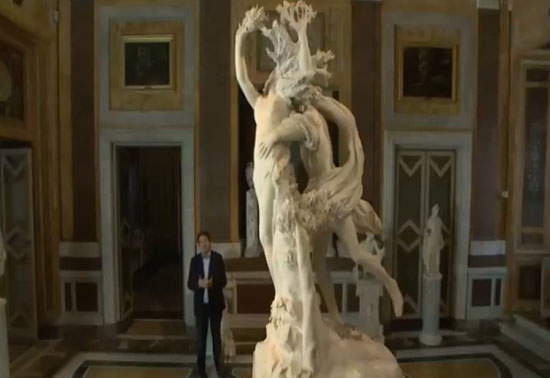Bernini's freedom: considerations after the first installment of the series
RAI is finally bringing us great art in prime time thanks to the project Bernini’s Freedom, an eight-part series that, through Tomaso Montanari’s narration, takes the reader through the work of one of the greatest protagonists of Italian art, Gian Lorenzo Bernini. Yesterday, January 7, RAI 5 broadcast the first episode.
The series immediately presents itself as a project without too many frills: background music reduced to the bone, Montanari as the sole and undisputed protagonist (perhaps even more than Bernini himself?), a direct and incisive style, as far as we have seen up to this point. There are at least three strengths of the series. The first: Montanari takes us directly to the places where Bernini lived and worked, and speaks to us in front of Bernini’s works. Which allows the listener to make direct contact and become more in tune with theartist. The second: the contextualization appears very effective and comprehensive. That is, Montanari really took us inside Bernini’s formative path, telling us about Michelangelo, Caravaggio, the Carraccis, Rubens, and what were the cues Bernini took from these artists. And finally, the third one: Montanari seemed almost always very clear in putting the listener in a position to understand the topics covered in the course of the episode. A disclosure that in my opinion goes in the opposite direction from that of, for example, Philippe Daverio (to give an example dear to the audience, which I imagine has Daverio’s Passepartout well in mind): while having in common with Daverio the distance from an academicism that would be detrimental to a broadcast of this kind, Montanari’s is a sober, aseptic (perhaps even too much so) eloquence characterized by gestures that are less emphatic and, above all, less stereotyped (as well as by a less serious vocal approach) than Daverio’s.

However, some weaknesses could not be missed. Montanari is still an art historian, and this belonging to a certain type of milieu makes itself felt, sometimes in the language (just to give an example: the locution “in an assertive manner” cannot really be heard in a program designed for the general public) and sometimes even in some passages that are a bit too “Montanari-like.” In fact, ours could have avoided the metaphor comparing cultural heritage to apples (that which is widespread and still in its original location would be comparable to “apples on trees” and instead that of museums is comparable to apples stored in a refrigerator): in order to understand what Montanari means, since he does not explain to the public why, according to him, museums would be like refrigerators, one must have read at least a few of his articles. And that is an exercise that cannot be proposed to a television audience. Or the passage where Antonio Coppola ’s portrait becomes a “still life”: why?
As for content, here too we would perhaps have preferred Montanari to tell us more about the historical context (not a mention of the events affecting Rome at the time, which were fundamental for understanding the developments of Caravaggio ’s art first and Bernini’s later: but perhaps there will be time in future installments) and above all that he better clarify the revolutionary scope of the Carracci’s art. Annibale Carracci’s is a name with which, probably, the wider television audience does not yet have that familiarity thanks to which the program may omit important passages. Example? To make clear what the Carracci’s way of looking at nature was, especially since the Cerasi Chapel also gave a way to make a direct comparison with Caravaggio (a comparison that was, instead, minimal).
In short: we are not yet up to the standard of something like Simon Schama’s Power of art, but we are at a far higher level than Passepartout. The premises are good, Bernini’s Freedom is a well-made and well-researched program, and it is a way of dealing with art that has not been seen on Italian television networks for some time. There are some small gaps, but we hope they will be filled with the next episodes. For sure, next Wednesday we will still be tuned in to RAI 5 :-)
Warning: the translation into English of the original Italian article was created using automatic tools. We undertake to review all articles, but we do not guarantee the total absence of inaccuracies in the translation due to the program. You can find the original by clicking on the ITA button. If you find any mistake,please contact us.





























